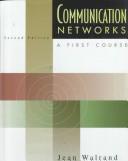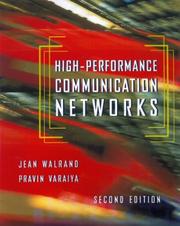| Listing 1 - 10 of 20 | << page >> |
Sort by
|

ISBN: 0256088640 Year: 1991 Publisher: Homewood, IL : Richard D. Irwin,
Abstract | Keywords | Export | Availability | Bookmark
 Loading...
Loading...Choose an application
- Reference Manager
- EndNote
- RefWorks (Direct export to RefWorks)
Computer networks --- Réseaux d'ordinateurs --- #TELE:SISTA --- Réseaux d'ordinateurs --- Communication systems, Computer --- Computer communication systems --- Data networks, Computer --- ECNs (Electronic communication networks) --- Electronic communication networks --- Networks, Computer --- Teleprocessing networks --- Data transmission systems --- Digital communications --- Electronic systems --- Information networks --- Telecommunication --- Cyberinfrastructure --- Electronic data processing --- Network computers --- Distributed processing
Book
ISBN: 0134938186 9780134938189 Year: 1988 Publisher: London : Prentice-Hall International,
Abstract | Keywords | Export | Availability | Bookmark
 Loading...
Loading...Choose an application
- Reference Manager
- EndNote
- RefWorks (Direct export to RefWorks)

ISBN: 0256174040 007114871X Year: 1998 Publisher: Boston, Mass. WCB-McGraw-Hill
Abstract | Keywords | Export | Availability | Bookmark
 Loading...
Loading...Choose an application
- Reference Manager
- EndNote
- RefWorks (Direct export to RefWorks)
Computer networks --- 681.3*D44 --- Communication systems, Computer --- Computer communication systems --- Data networks, Computer --- ECNs (Electronic communication networks) --- Electronic communication networks --- Networks, Computer --- Teleprocessing networks --- Data transmission systems --- Digital communications --- Electronic systems --- Information networks --- Telecommunication --- Cyberinfrastructure --- Electronic data processing --- Network computers --- Communications management: buffering; input/output; message sending; network communication; terminal management (Operating systems)--See also {?681.3*C2} --- Distributed processing --- 681.3*D44 Communications management: buffering; input/output; message sending; network communication; terminal management (Operating systems)--See also {?681.3*C2} --- Computer architecture. Operating systems --- Réseaux d'ordinateurs
Book
ISBN: 3030499952 3030499944 Year: 2021 Publisher: Cham : Springer International Publishing AG,
Abstract | Keywords | Export | Availability | Bookmark
 Loading...
Loading...Choose an application
- Reference Manager
- EndNote
- RefWorks (Direct export to RefWorks)
This revised textbook motivates and illustrates the techniques of applied probability by applications in electrical engineering and computer science (EECS). The author presents information processing and communication systems that use algorithms based on probabilistic models and techniques, including web searches, digital links, speech recognition, GPS, route planning, recommendation systems, classification, and estimation. He then explains how these applications work and, along the way, provides the readers with the understanding of the key concepts and methods of applied probability. Python labs enable the readers to experiment and consolidate their understanding. The book includes homework, solutions, and Jupyter notebooks. This edition includes new topics such as Boosting, Multi-armed bandits, statistical tests, social networks, queuing networks, and neural networks. For ancillaries related to this book, including examples of Python demos and also Python labs used in Berkeley, please email Mary James at mary.james@springer.com. This is an open access book.
Maths for computer scientists --- Communications engineering / telecommunications --- Maths for engineers --- Probability & statistics --- Probability and Statistics in Computer Science --- Communications Engineering, Networks --- Mathematical and Computational Engineering --- Probability Theory and Stochastic Processes --- Statistics for Engineering, Physics, Computer Science, Chemistry and Earth Sciences --- Mathematical and Computational Engineering Applications --- Probability Theory --- Statistics in Engineering, Physics, Computer Science, Chemistry and Earth Sciences --- Applied probability --- Hypothesis testing --- Detection theory --- Expectation maximization --- Stochastic dynamic programming --- Machine learning --- Stochastic gradient descent --- Deep neural networks --- Matrix completion --- Linear and polynomial regression --- Open Access --- Mathematical & statistical software --- Stochastics
Dissertation
Year: 1974 Publisher: Liège : Université de Liège, Faculté des sciences appliquées (ULg),
Abstract | Keywords | Export | Availability | Bookmark
 Loading...
Loading...Choose an application
- Reference Manager
- EndNote
- RefWorks (Direct export to RefWorks)
Algèbre. --- Algebra --- Theorie des systemes --- Algèbre.

ISBN: 1558605746 1558606548 0080508030 9786613931719 1283619261 9781558606548 9781558605749 Year: 2000 Publisher: San Francisco (Calif.): Morgan Kaufmann
Abstract | Keywords | Export | Availability | Bookmark
 Loading...
Loading...Choose an application
- Reference Manager
- EndNote
- RefWorks (Direct export to RefWorks)
Computer networks --- Multimedia systems --- High performance computing --- Asynchronous transfer mode --- Wireless communication systems --- Réseaux d'ordinateurs --- Multimédia --- Superinformatique --- Mode de transfert asynchrone --- Transmission sans fil --- Communication systems, Wireless --- Wireless data communication systems --- Wireless information networks --- Wireless telecommunication systems --- Telecommunication systems --- ATM (Data transmission) --- Broadband communication systems --- Packet switching (Data transmission) --- HPC (Computer science) --- Electronic data processing --- Cyberinfrastructure --- Supercomputers --- Computer-based multimedia information systems --- Multimedia computing --- Multimedia information systems --- Multimedia knowledge systems --- Information storage and retrieval systems --- Communication systems, Computer --- Computer communication systems --- Data networks, Computer --- ECNs (Electronic communication networks) --- Electronic communication networks --- Networks, Computer --- Teleprocessing networks --- Data transmission systems --- Digital communications --- Electronic systems --- Information networks --- Telecommunication --- Network computers --- Distributed processing --- Asynchronous transfer mode. --- Computer networks. --- High performance computing. --- Multimedia systems. --- Wireless communication systems. --- Réseaux d'ordinateurs --- Multimédia
Book
ISBN: 9781608454624 9781608454617 Year: 2010 Publisher: San Rafael, Calif. (1537 Fourth Street, San Rafael, CA 94901 USA) Morgan & Claypool
Abstract | Keywords | Export | Availability | Bookmark
 Loading...
Loading...Choose an application
- Reference Manager
- EndNote
- RefWorks (Direct export to RefWorks)
Book
ISBN: 3031799860 Year: 2010 Publisher: Cham : Springer International Publishing : Imprint: Springer,
Abstract | Keywords | Export | Availability | Bookmark
 Loading...
Loading...Choose an application
- Reference Manager
- EndNote
- RefWorks (Direct export to RefWorks)
This book results from many years of teaching an upper division course on communication networks in the EECS department at University of California, Berkeley. It is motivated by the perceived need for an easily accessible textbook that puts emphasis on the core concepts behind current and next generation networks. After an overview of how today's Internet works and a discussion of the main principles behind its architecture, we discuss the key ideas behind Ethernet, WiFi networks, routing, internetworking and TCP. To make the book as self contained as possible, brief discussions of probability and Markov chain concepts are included in the appendices. This is followed by a brief discussion of mathematical models that provide insight into the operations of network protocols. Next, the main ideas behind the new generation of wireless networks based on WiMAX and LTE, and the notion of QoS are presented. A concise discussion of the physical layer technologies underlying various networks is also included. Finally, a sampling of topics is presented that may have significant influence on the future evolution of networks including overlay networks like content delivery and peer-to-peer networks, sensor networks, distributed algorithms, Byzantine agreement and source compression. Table of Contents: The Internet / Principles / Ethernet / WiFi / Routing / Internetworking / Transport / Models / WiMAX & LTE / QOS / Physical Layer / Additional Topics.
Book
ISBN: 3031792661 Year: 2014 Publisher: Cham : Springer International Publishing : Imprint: Springer,
Abstract | Keywords | Export | Availability | Bookmark
 Loading...
Loading...Choose an application
- Reference Manager
- EndNote
- RefWorks (Direct export to RefWorks)
Resource Allocation lies at the heart of network control. In the early days of the Internet the scarcest resource was bandwidth, but as the network has evolved to become an essential utility in the lives of billions, the nature of the resource allocation problem has changed. This book attempts to describe the facets of resource allocation that are most relevant to modern networks. It is targeted at graduate students and researchers who have an introductory background in networking and who desire to internalize core concepts before designing new protocols and applications. We start from the fundamental question: what problem does network resource allocation solve? This leads us, in Chapter 1, to examine what it means to satisfy a set of user applications that have different requirements of the network, and to problems in Social Choice Theory. We find that while capturing these preferences in terms of utility is clean and rigorous, there are significant limitations to this choice. Chapter 2 focuses on sharing divisible resources such as links and spectrum. Both of these resources are somewhat atypical -- a link is most accurately modeled as a queue in our context, but this leads to the analytical intractability of queueing theory, and spectrum allocation methods involve dealing with interference, a poorly understood phenomenon. Chapters 3 and 4 are introductions to two allocation workhorses: auctions and matching. In these chapters we allow the users to game the system (i.e., to be strategic), but don't allow them to collude. In Chapter 5, we relax this restriction and focus on collaboration. Finally, in Chapter 6, we discuss the theoretical yet fundamental issue of stability. Here, our contribution is mostly on making a mathematically abstruse subdiscipline more accessible without losing too much generality.
Book
ISBN: 3031799925 Year: 2010 Publisher: Cham : Springer International Publishing : Imprint: Springer,
Abstract | Keywords | Export | Availability | Bookmark
 Loading...
Loading...Choose an application
- Reference Manager
- EndNote
- RefWorks (Direct export to RefWorks)
In this book, we consider the problem of achieving the maximum throughput and utility in a class of networks with resource-sharing constraints. This is a classical problem of great importance. In the context of wireless networks, we first propose a fully distributed scheduling algorithm that achieves the maximum throughput. Inspired by CSMA (Carrier Sense Multiple Access), which is widely deployed in today's wireless networks, our algorithm is simple, asynchronous, and easy to implement. Second, using a novel maximal-entropy technique, we combine the CSMA scheduling algorithm with congestion control to approach the maximum utility. Also, we further show that CSMA scheduling is a modular MAC-layer algorithm that can work with other protocols in the transport layer and network layer. Third, for wireless networks where packet collisions are unavoidable, we establish a general analytical model and extend the above algorithms to that case. Stochastic Processing Networks (SPNs) model manufacturing, communication, and service systems. In manufacturing networks, for example, tasks require parts and resources to produce other parts. SPNs are more general than queueing networks and pose novel challenges to throughput-optimum scheduling. We proposes a "deficit maximum weight" (DMW) algorithm to achieve throughput optimality and maximize the net utility of the production in SPNs. Table of Contents: Introduction / Overview / Scheduling in Wireless Networks / Utility Maximization in Wireless Networks / Distributed CSMA Scheduling with Collisions / Stochastic Processing networks.
| Listing 1 - 10 of 20 | << page >> |
Sort by
|

 Search
Search Feedback
Feedback About UniCat
About UniCat  Help
Help News
News